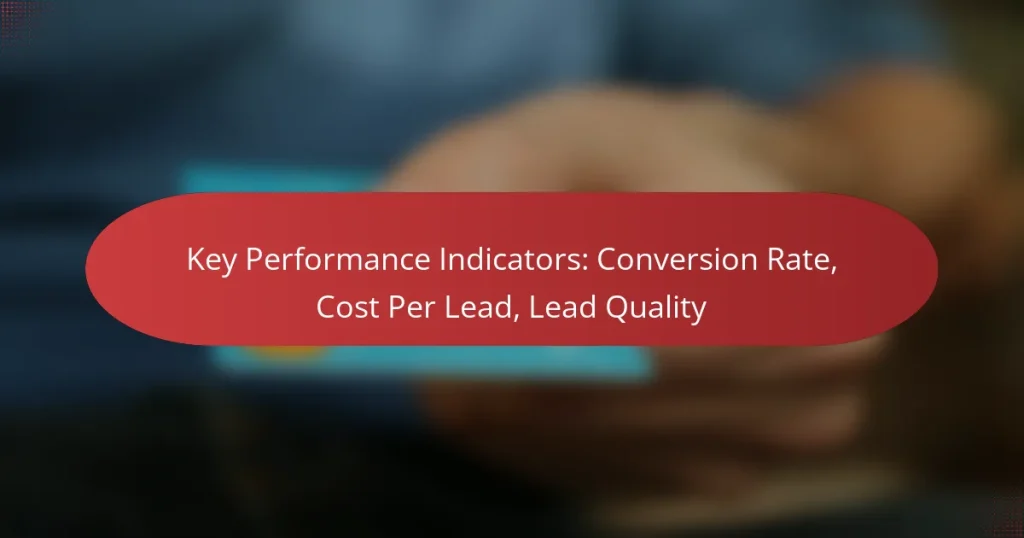Effective lead generation performance analysis is crucial for optimizing marketing strategies and improving campaign outcomes. By focusing on key metrics such as cost per lead, conversion rates, and lead quality, businesses can gain valuable insights into their efforts. Utilizing analytics tools and testing various strategies further enhances the ability to track and refine lead generation processes.
Lead Generation Metrics: Benchmarking, Industry Standards, Performance
Lead Generation Tools: Data Visualization, Insights, Analysis
Sales Funnel Stages: Awareness, Consideration, Decision
Key Performance Indicators: Conversion Rate, Cost Per Lead, Lead Quality
Lead Generation: Google Analytics, Effectiveness Measurement
Lead Generation Audit: Process, Metrics, Improvement Strategies
How to analyze lead generation performance effectively?
To analyze lead generation performance effectively, focus on key metrics that reflect the success of your campaigns. This involves using analytics tools, testing different strategies, and tracking the sources and conversion rates of your leads.
Utilize analytics tools like Google Analytics
Google Analytics provides valuable insights into user behavior, traffic sources, and conversion paths. Set up goals to track specific actions, such as form submissions or downloads, which can help you measure lead generation success.
Consider integrating Google Tag Manager for more advanced tracking capabilities. This allows you to monitor events without altering your website’s code, making it easier to adapt to changing marketing strategies.
Implement A/B testing for campaigns
A/B testing involves comparing two versions of a campaign to determine which performs better. Test different headlines, calls-to-action, or landing page designs to see what resonates most with your audience.
Start with small changes and analyze the results over a few weeks to gather sufficient data. Aim for a minimum of 100 conversions for reliable results, adjusting your strategy based on the findings.
Track conversion rates and ROI
Monitoring conversion rates helps you understand how effectively your leads are being converted into customers. Calculate your ROI by comparing the revenue generated from leads against the costs incurred in your lead generation efforts.
Use a simple formula: ROI = (Net Profit / Cost of Investment) x 100. This will give you a percentage that indicates the effectiveness of your lead generation strategies.
Monitor lead source performance
Identifying which sources generate the most leads is crucial for optimizing your marketing efforts. Use UTM parameters to track the performance of different channels, such as social media, email, or paid ads.
Regularly review this data to allocate your budget effectively. If a particular source consistently underperforms, consider reallocating resources to higher-performing channels to maximize your lead generation potential.
What metrics are essential for lead generation analysis?
Essential metrics for lead generation analysis include cost per lead, lead conversion rate, customer acquisition cost, and lead quality score. These metrics provide insights into the effectiveness and efficiency of your lead generation efforts, helping to optimize strategies for better results.
Cost per lead (CPL)
Cost per lead (CPL) measures the total cost of acquiring a lead. This metric is calculated by dividing total marketing expenses by the number of leads generated, providing a clear picture of how much each lead costs your business.
To maintain a healthy CPL, aim for a balance between quality and quantity of leads. A lower CPL may indicate effective marketing, but if lead quality suffers, it could lead to higher conversion costs down the line. Generally, businesses should strive for a CPL that aligns with their industry standards.
Lead conversion rate
The lead conversion rate indicates the percentage of leads that successfully become paying customers. This metric is calculated by dividing the number of converted leads by the total number of leads, then multiplying by 100.
A high conversion rate suggests that your sales process is effective, while a low rate may signal issues in lead quality or sales tactics. Regularly analyzing this metric helps identify areas for improvement, such as refining your sales pitch or enhancing follow-up strategies.
Customer acquisition cost (CAC)
Customer acquisition cost (CAC) represents the total cost of acquiring a new customer, including marketing and sales expenses. To calculate CAC, divide total costs by the number of new customers acquired in a specific period.
Monitoring CAC is crucial for understanding the sustainability of your business model. Ideally, CAC should be significantly lower than the lifetime value of a customer (LTV). If CAC is too high, consider optimizing your marketing strategies or improving lead quality to ensure profitability.
Lead quality score
Lead quality score is a metric that evaluates the potential of a lead to convert into a customer. This score can be derived from various factors, including demographic information, engagement levels, and behavioral data.
Assigning a quality score helps prioritize leads for sales teams, allowing them to focus on those most likely to convert. Regularly reviewing and adjusting scoring criteria based on conversion data can enhance the accuracy of this metric and improve overall lead generation effectiveness.
Which tools enhance lead generation performance analysis?
Several tools can significantly improve lead generation performance analysis by providing insights into customer behavior and campaign effectiveness. Utilizing the right combination of these tools can streamline your analysis process and enhance your marketing strategies.
HubSpot for CRM and analytics
HubSpot is a comprehensive platform that integrates customer relationship management (CRM) with analytics capabilities. It allows businesses to track leads throughout the sales funnel, providing detailed insights into lead behavior and engagement.
With HubSpot, you can analyze metrics such as lead conversion rates, email open rates, and website traffic sources. This data helps identify which marketing efforts are most effective and where improvements are needed.
To maximize HubSpot’s potential, regularly review your dashboards and reports. Set specific goals for lead generation and use the insights to adjust your strategies accordingly.
SEMrush for keyword tracking
SEMrush is a powerful tool for tracking keywords and analyzing search engine optimization (SEO) performance. It helps businesses understand which keywords are driving traffic to their sites and how they rank against competitors.
By using SEMrush, you can identify high-performing keywords that attract potential leads and optimize your content accordingly. Regularly monitoring keyword performance can lead to better visibility and increased lead generation.
Consider setting up alerts for significant changes in keyword rankings. This proactive approach allows you to respond quickly to shifts in search trends and maintain your competitive edge.
Mailchimp for email campaign metrics
Mailchimp is widely recognized for its email marketing capabilities, offering robust metrics to analyze campaign performance. It provides insights into open rates, click-through rates, and subscriber engagement, which are crucial for evaluating lead generation efforts.
With Mailchimp, you can segment your audience based on behavior and preferences, allowing for targeted campaigns that resonate with specific groups. This targeted approach often results in higher conversion rates.
To enhance your email campaigns, regularly test different subject lines and content formats. A/B testing can reveal what resonates best with your audience, leading to improved lead generation outcomes.
What are common pitfalls in lead generation analysis?
Common pitfalls in lead generation analysis include overlooking data segmentation, prioritizing quantity over quality, and failing to implement effective follow-up strategies. Addressing these issues is crucial for maximizing lead conversion and ensuring a more efficient marketing process.
Ignoring data segmentation
Data segmentation involves dividing leads into distinct groups based on characteristics such as demographics, behavior, or interests. Ignoring this practice can lead to ineffective targeting and wasted resources, as a one-size-fits-all approach rarely resonates with diverse audiences.
To improve lead generation outcomes, segment your leads into categories that reflect their potential value and engagement levels. For instance, you might categorize leads as high, medium, or low potential based on their interaction with your brand.
Focusing solely on quantity over quality
Prioritizing the number of leads generated rather than their quality can dilute your marketing efforts. High-quality leads, which are more likely to convert, often come from targeted campaigns that focus on specific audiences rather than mass outreach.
To ensure quality, consider implementing lead scoring systems that evaluate leads based on their engagement and fit with your ideal customer profile. This approach helps you concentrate your resources on leads that are more likely to convert, ultimately improving your return on investment.
Neglecting follow-up strategies
Effective follow-up strategies are essential for nurturing leads and guiding them through the sales funnel. Neglecting this aspect can result in lost opportunities, as many leads require multiple touchpoints before making a purchase decision.
Establish a structured follow-up process that includes timely emails, phone calls, or personalized messages. Aim for a follow-up within a few days of initial contact, and consider using automated tools to streamline this process while maintaining a personal touch.
How to improve lead generation strategies in major US cities?
Improving lead generation strategies in major US cities involves leveraging local insights and optimizing digital presence. Focus on targeted marketing efforts that resonate with the specific demographics and preferences of each city.
Local SEO optimization
Local SEO optimization is crucial for enhancing visibility in specific geographic areas. By optimizing your website and online profiles for local search terms, you can attract more relevant leads from your target cities.
Key steps include claiming your Google My Business listing, ensuring consistent NAP (Name, Address, Phone Number) information across platforms, and incorporating local keywords into your website content. For example, if you operate in San Francisco, use phrases like “best coffee shop in San Francisco” to capture local searches.
Additionally, consider gathering local reviews and engaging with community events to boost your local reputation. Avoid keyword stuffing and focus on creating valuable, locally relevant content that addresses the needs of your audience.





